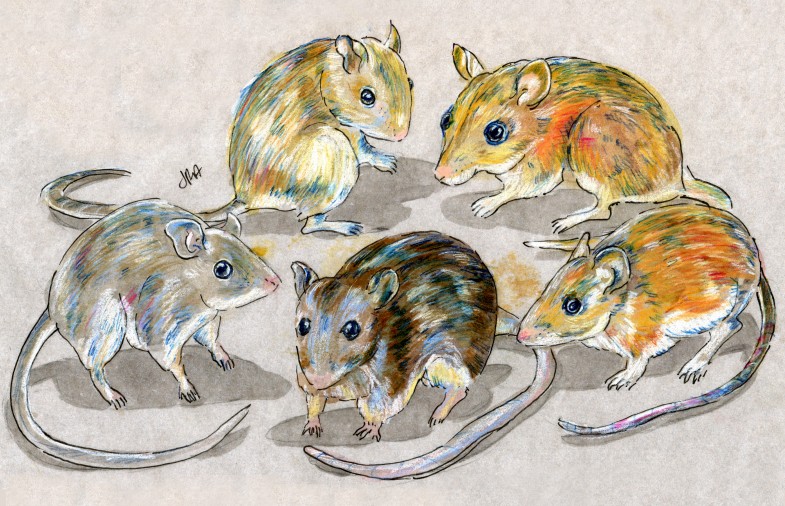CONTEST! Five Deer Mice: Aztec Mouse, California Mouse, Canyon Mouse, Gleaning Mouse, Hooper’s Deer Mouse
Those of you who have been following the Daily Mammal from the start know how daunting the rodents are. Nearly half of the 5,000 named mammal species are rodents, and as Ivan T. Sanderson says in Living Mammals of the World, “whole slews of these look almost exactly alike.” Not only are there are thousands and thousands of them, something I had not considered when I decided to begin this project, but there aren’t very good photos of a great many of them. A while back, I drew a set of five sleeping dormice, and found it heartening to check several rodents off the list at once. Here’s another of those multi-mouse drawings. This time we’re tackling five deer mice (major hantavirus carriers), of the Peromyscus genus.
I didn’t have photographs of a single one of these mice. Instead, I had photographs of Peromyscus species that are much more common in the US, and I had very detailed descriptions of these five species from the species accounts in Mammalian Species, which I download in PDF from Virginia Hayssen’s website. Now, let me tell you, I do not as yet speak the language of zoology, but I’m going to learn it. There are standard names for describing animals’ fur, or pelage, as we mammalogists call it: ochre, buffy, tawny, and a wash of brown may all mean tan to you and me, but not to those whose eyes are trained to discern the nuances. Would my biologist readers let me know where I can get a chart or something that shows what those colors really are? I read that Munsell Soil Color Charts are used for describing pelage—is that where these names come from? I’d like to know.
Anyway, in drawing these mice, I had only the scientific descriptions to go on, and only my experience with acrylic paints to help me decipher the meaning of the colors. (Well, that and the fact that I’ve known three cocker spaniels named Buffy.) Here’s where you come in.
CONTEST: I’m going to type, below, some hints from the descriptions of these mice. The first person to identify in a comment to this post which of the five is which wins this drawing, matted and ready for framing. Ted is not eligible. Here we go.
Aztec mouse (P. aztecus):
- Dorsal coloration is pale ochre mixed with black
- Sides are reddish
- Underparts are light buff
- A black orbital ring is present
- Size is medium
California mouse (P. californicus):
- Annulations are not thoroughly concealed
- Color is generally blackish brown above, sides ochraceous-tawny, venter pale olive gray to buffy brown
- Largest species of the genus in the United States
Canyon mouse (P. crinitus)
- Feet white
- Dorsal pelage silky
- Dorsal individual hairs lead-gray at base, succeeded by ochraceous to buffy subterminal band, and tipped with brown or back; dark grayish bases of hairs sometimes visible through buffy to pale grayish shade of dorsum
- Hairs of forehead, nose, and face appearing slightly more grayish than body
- Venter white
- Size small to medium for genus
Gleaning mouse (P. spicilegus)
- Unworn pelage has upperparts rich, tawny approaching ocherous rufous, dusky and dusky-tipped hairs uniformly distributed throughout upperparts
- Black or nearly black orbital ring extends posteriorly into a grizzled area between the eye and the base of the ear
- White feet
- Tail blackish-brown above, white below with coarse annulations
- Medium in size for the genus
Hooper’s deer mouse (P. hooperi)
- Upper parts grayish with faint to moderate wash of brown
- Underparts pale cream
- Hind feet and lower legs whitish
- Medium size for genus
Good luck!


This was tough…what’s supposed to be annulated? How can one tell if a dorsal pelage is silky? Is orbital related to the eyes, or is something else being orbited? What’s the difference between ocherous and ochraceous? Didn’t buffy slay vampires?
I’m impossibly confused; OK…best guess, going clockwise, starting with the upper left mouse, just to the right of the artist’s initials:
1 Hooper’s Deer Mouse
2 Aztec Mouse
3 Gleaning Mouse
4 California Mouse
5 Canyon Mouse
how about alphabetical order?
Aztec Mouse
California Mouse
Canyon Mouse
Gleaning Mouse
Hooper’s Deer Mouse
am i right?
Anna: This was a great post.
Starting with top left going clockwise:
1 Aztec
2 Hooper’s Deer
3 Canyon
4 California
5 Gleaning
That was fun and a different answer.
CW Starting with the dark guy at lower center: Cal, Hoop, Cany, Aztec, Gleam
Hi everyone! That was fast.
Dr. Hoo Hoo and Fishing Guy, thanks for your excellent attempts—you were both close, and Dr. Hoo Hoo just had two of them swapped. And Dr. HH, I was wondering the same thing about ocherous vs. ochraceous. You see what I’m up against?
Maggie, you are indeed correct about the alphabetical order of the mice…but the person who correctly identified all five mice is ChileJack! So he wins this contest.
He also happens to have won the genetic contest of being my dad! Perhaps his own familiarity with oil paints helped him with the ochre questions.
Clockwise from the top-left mouse, to the right of my initials, they are Canyon Mouse (Peromyscus crinitus), Aztec Mouse (Peromyscus aztecus), Gleaning Mouse (Peromyscus spicilegus), California Mouse (Peromyscus californicus), and Hooper’s Deer Mouse (Peromyscus hooperi).
Thanks, Jen. And it was actually geology that helped me. It’s similar to describing well cuttings under a microscope.
That’s why I was wondering if you had one of those Munsell Soil Color Charts. (My dad’s a geologist and an artist, everybody.) Although we’re talking about my drawing, and I have no experience describing well cuttings under a microscope and instead had to completely invent what I thought ochraceous-tawny and ocherous rufous looked like.
D’oh! I missed them all! Oh well. At least I can look forward to more cool rodent drawings later.